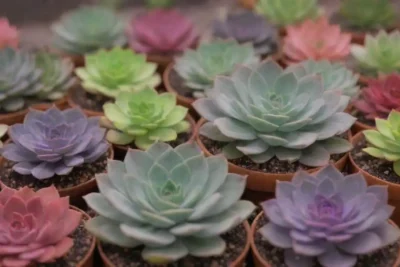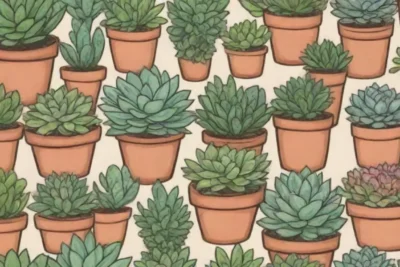
Strategies for Growing Succulents from Seed: A Complete Guide

Introduction
Growing succulents from seed is a rewarding and enjoyable gardening experience that opens up a world of possibilities for plant enthusiasts. Unlike more common propagation methods like cuttings or offsets, growing succulents from seed allows you to explore unique varieties and create a diverse collection of these resilient plants. While it may seem daunting, the process can be straightforward with the right guidance, patience, and care.
In this comprehensive guide, we will delve into the essential strategies for successfully growing succulents from seed. We will cover everything from seed selection to soil preparation, germination techniques, and post-germination care. By the end of this article, you will be well-equipped to start your journey on growing succulents from seeds, unlocking the potential for a flourishing collection of these charming plants.
Understanding Succulent Seeds
Succulent seeds have unique characteristics that distinguish them from other types of seeds. Generally, these seeds are tiny, often resembling a pepper grain, and they possess a hard outer shell that helps protect them from their surrounding environment. This structure is essential for their survival, as it prevents dehydration and helps them withstand harsh conditions. Familiarizing yourself with the types of succulent seeds is crucial for developing growth strategies.
Types of Succulent Seeds
The ecological diversity of succulents translates into a variety of seeds, each with its unique germination requirements. Broadly categorized, succulent seeds can belong to genera like Echeveria, Sedum, Aloe, and Lithops, to name a few. Each type has specific needs based on its native climate and growing conditions. For instance, seeds from warmer, arid regions often require specific temperatures to germinate, whereas seeds from cooler climates might need a different approach.
In addition to the generational differences, the moisture requirements can also vary significantly. Some seeds thrive in drier conditions, reflecting the environment of their adult forms, while others need a moist atmosphere for germination. Understanding these differences not only helps in selecting the right type of seeds but also informs the preparatory steps necessary to ensure successful growth.
Choosing Quality Seeds
When selecting succulent seeds, it is paramount to focus on quality. Choose seeds from reputable sources that specialize in succulents or cacti. Seeds should be fresh, as the germination rate of older seeds often diminishes significantly. Look for seeds that are labeled as organic and free from pesticides for the best chances of healthy growth in your future succulent plants.
Additionally, consider expanding your succulent knowledge by experimenting with hybrid seeds or more obscure varieties that might not always be readily available. This not only provides greater diversity in your collection but can also lead to the joy of discovering a new favorite plant.
 How Long Does It Take to Propagate Succulents Successfully?
How Long Does It Take to Propagate Succulents Successfully?Preparing for Germination
Once you have selected your succulent seeds, the next phase is preparing the right environment for germination. The correct soil mixture, temperature, humidity, and light conditions are crucial factors that will determine your success in raising these plants from seed.
Creating the Right Soil Mix
The foundation for healthy succulent growth starts with the right soil mix. For growing succulents from seed, a well-draining soil mixture is essential. A simple recipe includes equal parts of standard potting soil, perlite, and coarse sand. This blend allows for adequate moisture retention without waterlogging the seeds, which can lead to rot.
It’s vital to ensure that the soil you use is pathogen-free, as seedlings can be particularly vulnerable to diseases. Sterilizing your soil or purchasing pre-made mixes specifically formulated for succulents can make a significant difference. Additionally, using smaller pots or seed trays can help contain the soil and make it easier to monitor moisture levels.
Temperature and Humidity Control
Temperature is another crucial aspect to consider during the germination process. Most succulent seeds prefer warmth, ideally between 65°F to 80°F (18°C to 27°C). Placing your seed trays in a warm location, such as near a sunny windowsill or under grow lights, can create the perfect warmth to stimulate germination.
Maintaining the right humidity is equally important and can often be achieved by covering your seed tray with a humidity dome or plastic wrap. This creates a mini-greenhouse effect that retains moisture around the seeds. Regularly checking and adjusting the humidity level is advised—too much moisture can lead to mold growth, while too little might cause premature drying.
Lighting Conditions
Lastly, the lighting setup for your seeds is essential. Although they need warmth, sucrose propagation from seed requires bright, indirect light to germinate. Direct sunlight can be too harsh and may scorch the delicate seeds. If natural light is limited, consider investing in grow lights that mimic natural sunlight to provide adequate illumination for the germination period.
Germination Techniques

 A Detailed Investigation into Air Layering for Succulents
A Detailed Investigation into Air Layering for SucculentsNow that you have adequately prepared the soil and environment, it's time to establish effective germination techniques that promote healthy seed sprouting. Various methods can be employed for this process, ranging from traditional approaches to more innovative techniques.
Direct Sowing
The most straightforward method of germination is direct sowing. Simply sprinkle the seeds on the surface of the prepared soil in a seed tray or pot, without covering them, as many succulent seeds require light for germination. Mist the area lightly with water from a spray bottle to avoid washing the seeds away. Once germination occurs, thin out the seedlings to avoid overcrowding and ensure that each plant has enough room to grow.
This technique is advantageous because it allows for easy observation of the germination process. You can witness the small succulent seedlings sprouting from the soil, which can be rewarding and motivating for new gardeners. However, direct sowing does require vigilant monitoring of moisture levels, as the seed tray must be kept moist but not waterlogged.
Stratification
Some succulent seeds may benefit from a pre-germination treatment known as stratification. This method mimics natural seasonal changes, allowing seeds to experience a period of cold before germinating. To stratify your seeds, layer them in a moist paper towel and place the towel in a plastic bag, ensuring that air is sealed within. Refrigerate the bag for a few weeks before planting the seeds in their respective soil.
This technique can enhance germination rates for certain varieties while exposing the seeds to conditions that resemble their natural habitats. It is especially beneficial for seeds from regions that undergo extreme temperature variations throughout the year.
Using Water for Germination
Another innovative technique involves soaking seeds in water before planting. This method helps soften the hard outer shell of the seeds, which may speed up germination. To do this, soak your seeds in a glass of water for around 24 hours, then drain and sow them in your prepared soil. The soaked seeds are often more successful in sprouting quickly as they undergo a ‘pre-germination’, preparing them for growth.
Utilizing this strategy can be advantageous for those impatient to see immediate growth in their succulent garden. However, care must be taken to ensure that the seeds do not remain submerged in water for too long, as excess soaking can promote rot.
 The Benefits of Using Cloning Gel in Succulent Propagation
The Benefits of Using Cloning Gel in Succulent PropagationPost-Germination Care
Once your succulent seeds have germinated, the real journey begins. Post-germination care is crucial for establishing healthy seedlings that will grow into robust plants. It involves proper watering, fertilization, and acclimatization to ensure that the young plants thrive.
Watering Techniques
Watering is one of the most critical factors affecting the well-being of newly germinated succulent seeds. Overwatering can lead to damping-off disease, while underwatering can cause the seedlings to dry out. A light misting of the soil surface is usually sufficient for the first few weeks. As the seedlings mature, adjust the watering routine to allow the soil to dry out between sessions.
A helpful tip: To avoid damaging the seedlings, consider using a spray bottle instead of a watering can. This will ensure that water is evenly distributed and that delicate young plants aren't disturbed as they develop. It’s also a good idea to monitor the humidity levels under the cover you previously set up, gradually removing it as the seedlings adjust to environmental conditions.
Fertilization Guidelines
Fertilizing succulent seedlings should be approached with caution. Young, tender plants can be sensitive to overly rich fertilizers. Instead of traditional potting fertilizers, consider using a diluted succulent-specific fertilizer or a liquid fertilizer at a rate of one-quarter strength. Start applying it a few weeks after the seedlings have emerged – typically around the time they begin to develop their first true leaves.
During their growth, younger plants benefit from being fed every few weeks during the peak growing season (spring and summer), while reducing feeding frequency during their dormant phases (fall and winter). Frequent applications will help ensure healthy growth and vibrant coloring for your emerging succulent wonders.
Acclimatization to Outdoor Conditions
Once your seedlings have grown to a sufficient size and strength, it’s crucial to acclimatize them to their future home. This process, often referred to as 'hardening off', involves gradually exposing your seedlings to outdoor conditions to avoid shock.
Start by placing your seedlings in a shaded, protected area of your garden or on a balcony for a couple of hours each day. Gradually increase their outdoor exposure, including sunlight over a week or two. This will help them adjust to the temperature, light intensity, and air circulation they will experience in their permanent environment. After achieving successful acclimatization, you can then transplant them into their designated spots in your garden, pot, or terrarium.
 The Do's and Don'ts of Propagating Succulents in Bulk
The Do's and Don'ts of Propagating Succulents in BulkConclusion
Growing succulents from seed can be an exhilarating journey filled with opportunities for discovery and satisfaction. From selecting high-quality seeds to managing the germination and post-germination phases, you now have a thorough understanding of the various strategies required to succeed in this endeavor. Each aspect requires patience, dedication, and an openness to learn from experience as you nurture your seedlings into thriving plants.
As you embark on this journey, remember that patience is key when it comes to developing a successful succulent garden from seed. Germination can take anywhere from a few days to several weeks, depending on the species, so patience and consistent care are essential. Embrace the challenges and celebrate the successes as you watch your collection grow over time.
In conclusion, developing your skills in growing succulents from seed not only cultivates a remarkable floral hobby but also enriches your knowledge of botany and ecology. Whether you’re a beginner or an advanced gardener, these strategies will set you on the right path towards a successful and orating succulent garden that you can be proud of. Happy gardening!
If you want to read more articles similar to Strategies for Growing Succulents from Seed: A Complete Guide, you can visit the Propagation Methods category.






You Must Read